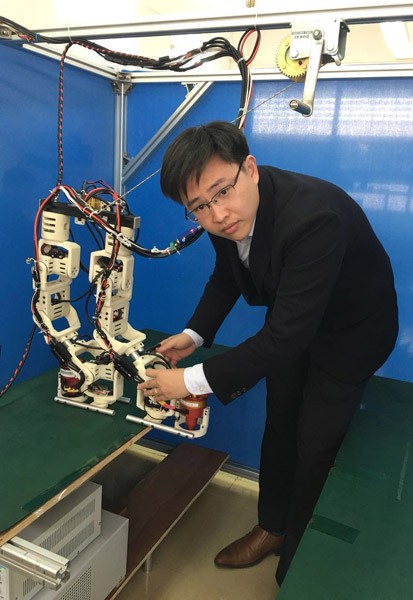Innovative robot learns how to walk


Forget about the robot soldiers marching through the human world in sci-fi movies. Two-legged robots in reality are mostly able to take only short steps and they're prone to falls.
But a robotic biped developed at Guangdong University of Technology is able to take a big step while maintaining balance thanks to ducted fans fixed to its feet.
Jet-HR1, the robot, resembles the lower part of a human body. It's 65 centimeters tall and weighs 6.5 kilograms. It can cross a gap of 45 cm, or 97 percent of its leg length, making a move like doing the splits.
This results in higher efficiency than the 20 percent of leg length commonly seen in other humanoid robots, said Huang Zhifeng, vice-dean of the university's Department of Automation, who has led the research over the past two years.
Crossing distances may sound easy for humans, who can mitigate the chances of falling through the use of dynamic walking, or constantly falling forward.
For the less dynamic, or quasi-static, robot, it presents a significant challenge because the longer the step, the more its center of gravity moves toward the leg taking the step, and the greater the chance of falling.
A ducted fan jet engine weighs 232 grams but can produce up to 2 kg of thrust-one-third of the total weight of the Jet-HR1. The magnitude of the propulsion is calculated so that the robot can make different moves in different conditions.
The robot was depicted in a recent article published in IEEE Spectrum, the flagship magazine of the Institute of Electrical and Electronics Engineers, a major international professional organization.
Huang was studying in Japan when that country was hit by a massive earthquake and tsunami in 2011, and he noticed the weak performance of robots in relief efforts at the damaged Fukushima nuclear power plant.
As a fan of the international robot competitions organized by the United States Department of Defense in 2013 and 2015, Huang is aware of the weaknesses in even the winning robots.
Robots are often focused on a single action, such as climbing, he said.
"We tend not to do follow-up research but rather like to start a new subject, take a new direction. In a new direction, we may face new problems. We address them and will have a brand-new thing," he said.
"To this end, you have to be bold, because people may see it as impossible or meaningless. But when you make a successful first step, they will see the effect and recognize the way you do it. And you move forward."
In experiments, the Jet-HR1 is logging about 50 percent success. To improve its performance, it needs better engines and better systems for maintaining balance. If put in a real situation, it needs to be fixed with a microcomputer for calculation and a sensor for judging distances.
A longer-term goal for Huang's team is to enable the robot to jump to a higher floor of a building. The jet engines help reduce the impact when the robot performs dynamic motions, he said.
"Good research takes at least 10 years," Huang said.
The robot should be adaptable to demanding situations, such as performing work in an earthquake-damaged area or on the surface of another planet, he said.
- Breakthrough in brain-machine interface technology empowers paralyzed patients
- UNIDROIT to establish Asia-Pacific office in Hong Kong
- Chinese scientists discover new fossil lungfish species
- 64 sculptors build 19-meter-tall snowman in Harbin
- Study reveals thirdhand smoke as hidden indoor air pollutants
- Meeting held to mark China National Democratic Construction Association's 80th founding anniversary





































